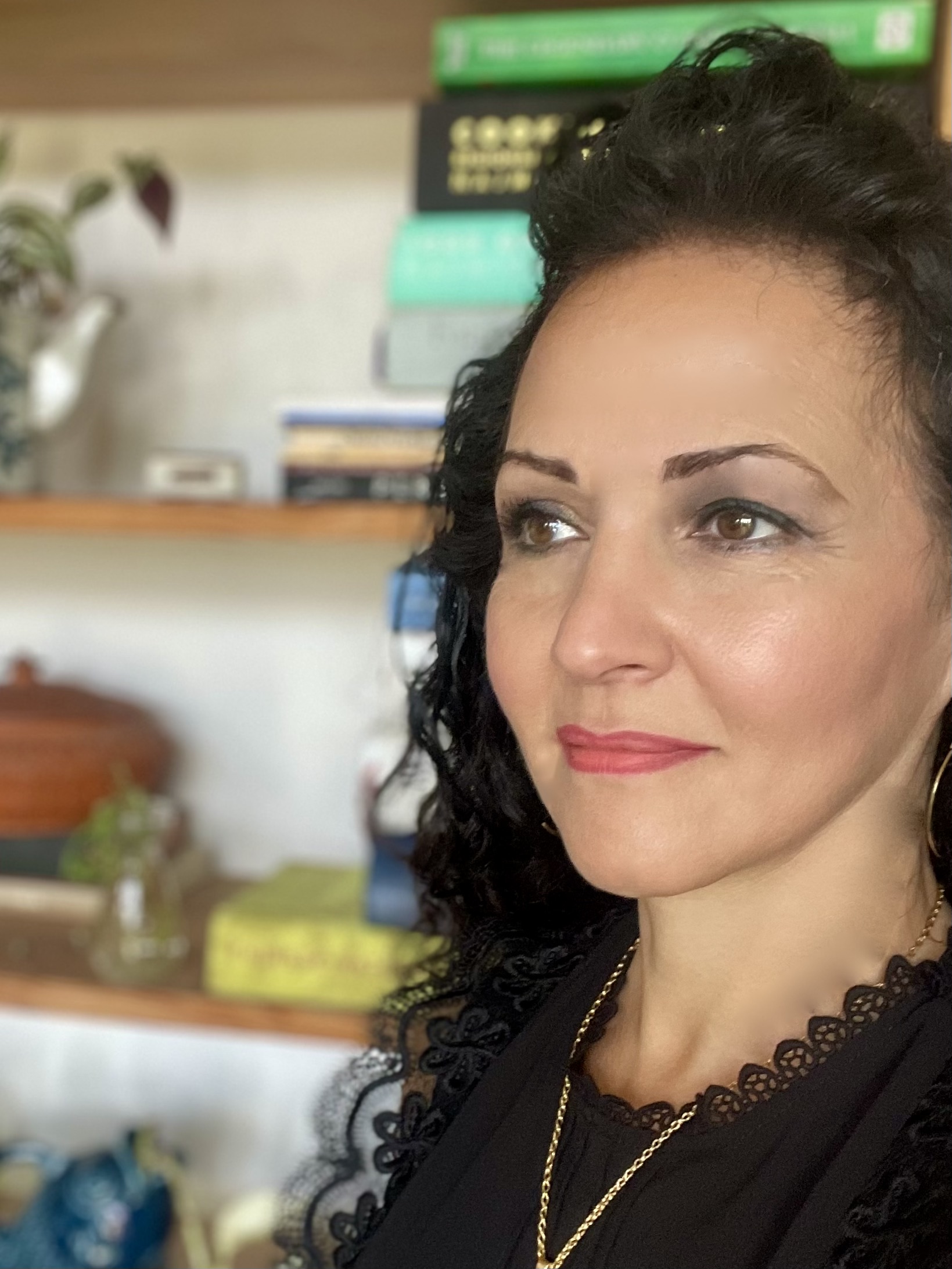Nowruz Bayramuz mobarakdi
Nowruz or New Year celebrations of the people of Greater Iran start at the exact time of the Vernal equinox, this year that was at 3.06 am GMT on 20th of March known as tahvil when earth starts its new revolution around the sun. For my mother it was at 6.36, in Tabriz, Iran. When my sister lived in Australia, for her it wasn’t just a different date and time but season too. This is a modern oddity for the diaspora celebrating Nowruz around the world. At the time of tahvil, we will stand around our sofreyeh haft sin (detailed below) in our best bib and tucker, candles lit, with a clean heart and home filled with spring flowers, fruit and Nowruz sweetmeat. A modern addition is to have group chat open on a laptop to celebrate with loved ones all over the world!

As with most cultures around the world, the seasons are heralded with rituals. Nowruz is an ancient secular and cultural festival. There are preparations, get-togethers, exchanges of presents and special foods. There seems to be a natural hopefulness and anticipation about this time of year for all nature, us humans included. We look forward to new beginnings and the coming of longer and warmer days.
On the 20th of March, Iranians entered the year of 1403. It seems a bit strange to think that not all the world is in 2024. Those of you who follow horoscopes will know that we go into new constellations or star signs around the 20th of each month. The Iranians still use these natural phenomena to set their calendars.
You may ask what we do for our new year. Well, the preparations start weeks in advance, for me starting with soaking and sprouting grains for the haft sin table. Below are photos of my sprouting lentils which I shared with Iranians around the world with the Instagram hashtag #sabzeh. Then there is Khaneh Tekanki, literally translated as ‘shaking the house’ or spring cleaning. In times gone by this would be the time of buying new clothes for the coming year and presents.

Two of my favourite Nowruz preparation memories are food related, the first, when I learned how to make louz in Soraya Khanum’s house in Tabriz. She is the queen of louz, they are little saffron flavoured almond sweets cut into diamond shapes traditionally served in Azerbaijan. The second, when I made samanoo, it took me a couple of weeks to make it, during the process I was awestruck by our ancestor’s ingenuity to turn wheat into a sweet miso-like nutritious paste.

The most fun part of the preparations is a bit of pyromania. On Tuesday 12th of March, I put down candles in the living room and jumped over them as it was raining so I couldn’t do it in the garden or allotment. We mark the four last Wednesday evenings (held on Tuesday) before new year with an element, the final Wednesday’s element is fire. This day is called Chaharshanbeh soori -scarlet Wednesday in Farsi and Akhir Chaharshanba – last Wednesday in Azeri. For millennia, the peoples of the region have built fires and jumped over them in a symbolic act of cleansing, change of fortune, seeing the old year out, and the new one in. It is very human to gather around a fire with loved ones and feel comforted by its glow and warmed by its energy.

In Farsi-speaking areas, when people jump over the fire they ask for the fire’s rosy glow in place of their winter pallor; in Azerbaijan we ask for fortune to be opened.
On this day we bang spoons on pans and make noise to frighten away evil spirits whilst knocking on doors and asking for treats. You might be thinking of the similarities with Halloween (children asking for treats), Wassailing (banging pots to ward off evil spirits) and Chinese New Year (significance of red, firecrackers): well, you are right. The observance of equinoxes, solstices and other goings on in nature seem to be universal to humankind. Arbitrary lines on maps don’t alter the fact that we are all the same. For example, in some areas of China, brides walk over fire to burn off their bad luck, in Northern Europe, the feast of St John (mid-summer solstice) was marked by building fires to ward off evil: people partied and, yes, jumped over them!
In days gone by chaharshanbeh soori celebrations would have been more elaborate. It is fantastic to think that whole nations still gather in gardens, parks and streets, every year, to continue the tradition. No matter the weather or where I am in the world, on the eve of the last Wednesday before the vernal equinox and Nowruz, I leap into the new year. In the photos below: jumping In Iran, indoors in the UK as it was raining, on the allotment and a few years ago on holiday in France.

We get a bit hungry cleaning, cooking and jumping over it so we need a little something to keep us going. Ajil is a general term for mixed nuts and dried fruit. Each family has its own mix of Chaharshanbe Soori ajil or akhir chaharshanbe yemish in Azeri. Usually, this is un-roasted or salted dried fruit and nuts which might consists of various types of dried grapes such as sultans, green and brown raisins, currants, dates, pistachios, almonds, walnuts, hazelnut, stuffed dried pears and peaches known as mianpour, soojugh and baslugh. The Ajil shops are always beautifully dressed at this time of year with large copper trays filled high with nuts and dried fruit. In our home the best dried fruits and nuts, which were picked in the autumn, dried and stored, come out. My mother puts handfuls of each and mixes them as the ajil. She also throws a shelled nut or two into the corners of each room. This may be to bring about prosperity and a treat to happen upon in the days to come.

I mentioned sofeyeh Haft Sin above. This is a table laid with symbolic items; seven of these items begin with one of the four Ss, the Sin in the Persian alphabet sin. It happens to be the S with which my name starts so my mother would tease me as a child and say if she were short of an item she’d put me on the table.

Nowruz is said to be an ancient tradition from 3000 years ago. Naturally, as with most traditions, they alter through time with the change to the language, customs, traditions and I would also include technology. Here are some items beginning with Sin which might be found on a modern Sofreyeh Haft Sin alongside their most related symbolism:
Sonbol (hyacinth) heralds the coming of spring and brings a fragrant new year
Serkeh (vinegar or wine) wisdom or patience as it is always aged
Sabzi (sprouted greens) rebirth, purity
Sir (garlic) medicine
Senjed (fruit of the Oleaster tree) symbolises love
Seeb (apple) the fruit of the tree of knowledge
Sumac (powdered berries of the Rhus plant) I’ve read could symbolise the culinary art of Persia or the colour of the sun rise defeating darkness.
Sekeh (coins) wealth in the coming year
Samanoo (sweet paste) to show from humble origins with patience a sweet result is possible.
I’ll say a bit more about samanoo here.
Samanoo is a sweet paste which looks like dark miso and is made of sprouted wheat grains. I made it once years ago, it took me two weeks to make. It was one of the most incredible transformations of wheat, the ingenuity of our ancestors, I was awestruck.
Some of the other symbolic items on a Sofreyeh Haft Sin are a mirror to indicate a time of reflection, a goldfish to represent the movement from the constellation of Pisces into Aries, a lit candle for enlightenment, eggs usually coloured boiled eggs to symbolise fertility. Some have a citrus fruit in a bowl of water to symbolise the earth in space and a great book. This could be Divan of Hafez, Shahnameh, or a holy scripture to read from at the time of the Tahvil.

Once Tahvil has passed we wish each other a happy new year. The eldest in the family gives new cash notes put in the great book to each of those present and we then drink chai and eat something sweet be it sweetmeats or ajil and some of us pop corks. The customary dish to have on new year’s day is Sabzi Polow which is herb infused rice served with fish. Both of which are symbols from the Haft Sin.
Then the 12 days of celebrating begin. On the first day visits are made to the houses of the elders of the family and those who may have been bereaved in the year gone by. These are short visits where you are offered tea, sweetmeats and fruits. Typically, we would make six or seven short visits in the morning and another seven or eight in the afternoon and early evening. My mother receives guests on the second day. One year I was in Iran for Nowruz we had 90 visitors. For that purpose, my mother had rearranged the main reception and asked my cousins to help with the teas and serving of sweetmeats and fruits. As the days progress, younger members of the family and newlyweds are visited. On the thirteenth day, everyone packs a picnic and heads out into the country or parks in big cities to Sizdah bedar which means to see the thirteenth out. Thirteen is considered an unlucky number so much so that you won’t find a door number 13 in Iran they write 12 + 1 instead. It is also the time you throw your now quite tall sprouted lentils into running water and make a wish. I do this over a weir in Bath and watch it flow downstream.

I hope you have enjoyed this little window into one ancient, natural and humanist tradition and the similarities in the festivities that we have on our planet. I bid us all a healthy, peaceful and prosperous orbit around the sun.
For more please check my Instagram: @SimisKitchen
Simi owns and runs Simi’s Kitchen, she is a Bath based cookery teacher and organic gardener. She teaches world food specialising in the food of Central Asia. Currently she’s writing a book about a fermented dairy product from her heritage, Qurut, Cooking with Dried Yoghurt, out next year.
She was born on the Silk Road in Tabriz, Iran and grew up in Anglesey, north Wales. She studied for her first degree at the University of Bath, then lived and worked in Toronto for several years before returning to her alma mater to complete her PhD. She has worked in Ford Motor Company and HSBC and started Simi’s Kitchen in 2009.
She is a regular at the Oxford Food Symposium. Simi travels to Iran regularly to visit family, and to research recipes and ingredients which shares in her classes and writing.
Simi is offering guild members 10% off her classes with the code: GFW2024



